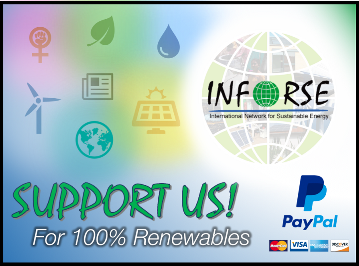|
|
|
|
|
|
|
|
|
|
|
|
|
|
|
|
|
|
|
|
|
| Follow Us: |
| Gender & Energy Development: | |
|
By Anushka G. Abeynayake, Denmark. Specialist and NGO activist within gender and development. |
|
| In November, 1999, I attended a workshop entitled, ‘Improving Women’s Access to Energy: Policy, Projects or the Markets?’, which was organised by ENERGIA. In the following text, I shall attempt a brief rundown of important points sparked off by these most inspiring and intensive two days. | |
| A Long History of Misjudgement | |
|
The identification of women’s energy needs in the ‘Third World’ seem often to have been linked to energy-efficient stoves and ovens, with a view to providing women with sustainable household energy and a source of income generation. Many such projects have proven unsustainable due to lack of serious user project-participation and of long-term commitment, pointing to donors’ misjudgement of users’ needs. Crippling of project sustainability due to failure to involve women stakeholders is not specific to the energy sector. It is an ongoing problem in development aid in general. A rich body of lessons learnt already exists. Compounding the errors, theories and practices culturally specific to the West are too often automatically applied to non-Western cultural and social contexts in which they usually are not appropriate. Such cultural errors can cause long term, unforeseen problems with adverse social, political, and/or economic repercussions. |
|
| Groundbreaking New Project Practices | |
|
There is thus a need to “listen right” in the design, implementation, evaluation, and monitoring of projects and programs to attain real project sustainability. It is important to listen to the women’s input directly and carefully, making sure to obtain a clear understanding of their concerns practical as well as socioeconomic. A particularly interesting, ground breaking work is carried out by the UNDP/World Bank’s Water Sanitation Program in South Asia based on qualitative and quantitative indicators developed by CIDA (Canadian Int’l Development Agency). Below is a listing of such indicators: • Base-line data are crucial to evaluating how well project objectives are met. These include data disaggregated by sex, ethnic grouping, and socioeconomic status. • Input indicators identify project resources: coverage of investment; instructional material and its relevance to women and to men. • Process indicators reflect ongoing monitoring of project implementation: decision-making processes and information feedback. • Output indicators measure results of product use and services towards the goals of the donor funding: number of facilities in working order, user views. • Impact indicators assess long-term sustainability and effectiveness: women’s views on benefits/disadvantages and impacts 3 to 5 years after donor funding has commenced. (Source: Guide to Gender Sensitive Indicators CIDA ,1997) (The article was edited by the editors) ENERGIA, International Network on Women and Sustainable Energy was established in 1995 and has 800 members all over the world. Contact: ENERGIA, P.O. Box 64, 3830 AB Leusden, The Netherlands. Ph. +33 33 494 3086, fax: +33 33 494 0791, e-mail: office@etcnl.nl, http://www.sms.utwente.nl/vakgr/vok/energia/. |
|
| Groundbreaking New Project Practices | |
|
There is thus a need to “listen right” in the design, implementation, evaluation, and monitoring of projects and programs to attain real project sustainability. It is important to listen to the women’s input directly and carefully, making sure to obtain a clear understanding of their concerns practical as well as socioeconomic. A particularly interesting, ground breaking work is carried out by the UNDP/World Bank’s Water Sanitation Program in South Asia based on qualitative and quantitative indicators developed by CIDA (Canadian Int’l Development Agency). Below is a listing of such indicators: • Base-line data are crucial to evaluating how well project objectives are met. These include data disaggregated by sex, ethnic grouping, and socioeconomic status. • Input indicators identify project resources: coverage of investment; instructional material and its relevance to women and to men. • Process indicators reflect ongoing monitoring of project implementation: decision-making processes and information feedback. • Output indicators measure results of product use and services towards the goals of the donor funding: number of facilities in working order, user views. • Impact indicators assess long-term sustainability and effectiveness: women’s views on benefits/disadvantages and impacts 3 to 5 years after donor funding has commenced. (Source: Guide to Gender Sensitive Indicators CIDA ,1997) (The article was edited by the editors) ENERGIA, International Network on Women and Sustainable Energy was established in 1995 and has 800 members all over the world. Contact: ENERGIA, P.O. Box 64, 3830 AB Leusden, The Netherlands. Ph. +33 33 494 3086, fax: +33 33 494 0791, e-mail: office@etcnl.nl, http://www.sms.utwente.nl/vakgr/vok/energia/. |
|

| |
| Published in Sustainable Energy News |
|
|
Go back to main page of ISSUE #28 (981KB) 20 pages (2000-02-28) |
|
| Contact | |
| |
INFORSE Secretariat Klosterport 4F, 1. floor DK-8000 Aarhus C Denmark Phone: +45 86 22 70 00 Twitter: INFORSE_org Facebook: INFORSE Web: inforse.org E-mail: ove@inforse.org |
